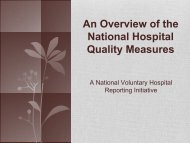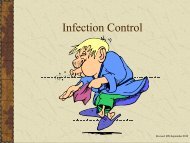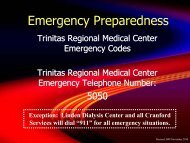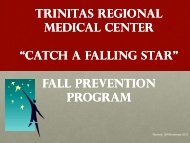Palliative Care and Pain Management - Trinitas Hospital
Palliative Care and Pain Management - Trinitas Hospital
Palliative Care and Pain Management - Trinitas Hospital
You also want an ePaper? Increase the reach of your titles
YUMPU automatically turns print PDFs into web optimized ePapers that Google loves.
<strong>Palliative</strong> <strong>Care</strong><br />
And<br />
<strong>Pain</strong> <strong>Management</strong><br />
Revised: bw/September 2010
<strong>Palliative</strong> <strong>Care</strong><br />
• Symptom management is a primary goal of<br />
palliative care.<br />
• <strong>Pain</strong> is one of the most feared symptoms<br />
experienced by patients.<br />
• Effective pain management is critical to<br />
healing, quality of life <strong>and</strong> patient<br />
satisfaction.
Key Concepts in <strong>Pain</strong> <strong>Management</strong><br />
1. Assessment<br />
a) reassess to prevent pain, not prn.<br />
2. A multi-disciplinary approach.<br />
3. Using pain relief methods effectively.<br />
4. Educating patients <strong>and</strong> their families.
<strong>Trinitas</strong> <strong>Pain</strong> <strong>Management</strong> Policy<br />
• All patients will be assessed for pain upon admission<br />
<strong>and</strong> at least once every 8 hours for inpatients <strong>and</strong> with<br />
each clinic visit for out patients.<br />
• The clinical staff will work together with the patient to<br />
establish a goal for pain relief <strong>and</strong> develop <strong>and</strong> implement<br />
a plan to achieve that goal.<br />
• Patients <strong>and</strong> their families will receive education about<br />
pain management to enable them to be active participants<br />
in their treatment plan.<br />
• <strong>Pain</strong> management will be incorporated into the<br />
discharge plan.
The <strong>Pain</strong> <strong>Management</strong> Team<br />
• Physicians<br />
• Nurses<br />
• Physical therapists<br />
• Occupational<br />
therapists<br />
• Mental health<br />
professionals<br />
• Social workers<br />
• Pharmacists<br />
• Religious or Spiritual<br />
leaders<br />
The Patient is part of the team, too!
What Is <strong>Pain</strong>?<br />
• <strong>Pain</strong> is physical<br />
– Damage to nerves <strong>and</strong> tissue due to disease, injury<br />
or infection<br />
• <strong>Pain</strong> is emotional<br />
– Stress, anxiety, trauma <strong>and</strong> depression play a role<br />
in a person’s suffering<br />
• No two people are the same<br />
– Two people with the same injury (or surgery)<br />
can experience different levels of pain<br />
• Some pain has no clear cause
<strong>Pain</strong> Relief Methods<br />
Used alone or in combination, include:<br />
• Medication<br />
• Cognitive <strong>and</strong> behavioral techniques (guided<br />
imagery, for example)<br />
• Exercise.<br />
• Physical agents (massage, heat <strong>and</strong> cold, etc.)
Education of Patients <strong>and</strong><br />
Families<br />
Patients <strong>and</strong> families<br />
must underst<strong>and</strong>:<br />
• The different types of pain <strong>and</strong><br />
pain relief options<br />
• The importance of reporting<br />
their pain<br />
• Why pain relief is important for<br />
recovery<br />
• The effectiveness of pain<br />
control measures<br />
Barriers to effective pain<br />
education <strong>and</strong> management:<br />
• Fear of addiction<br />
• Fear of legal problems<br />
• Worries about side effects<br />
• Cultural beliefs
<strong>Pain</strong> Assessment:<br />
• Many factors play a role in pain assessment for<br />
both the person being assessed <strong>and</strong> the person<br />
doing the assessment.<br />
• These factors include:<br />
– Culture<br />
– Age<br />
– Sex<br />
– Previous pain experiences<br />
– Fears <strong>and</strong> feelings about tolerance, dependency <strong>and</strong><br />
addiction
0 – 10 Numeric Scale<br />
• For use with adult patients &<br />
children age 7 <strong>and</strong> older<br />
– 0 indicating no pain <strong>and</strong> 10<br />
indicating the worst possible pain<br />
– Available in different languages<br />
– Patient must be educated in the use<br />
of the tools<br />
– Tools made available to patient <strong>and</strong><br />
family for reference
The Faces Scale (Wong-Baker)<br />
• For use with pediatric<br />
patients, ages 3-18<br />
– Can also be used with<br />
adults<br />
– 0 indicating no pain<br />
<strong>and</strong> 10 indicating the<br />
worst possible pain<br />
– Children must be<br />
taught how to use tool
FLACC Scale<br />
– A behavior pain assessment for use in non-verbal<br />
patients who are unable to provide reports of pain<br />
– Ratings are obtained in each measurement<br />
category. Scores are added together <strong>and</strong> a total<br />
pain score is obtained from 0-10<br />
– For use with adult patients who are cognitively<br />
impaired <strong>and</strong> for children ages 2 months to 7<br />
years
FLACC Scale<br />
FLACC Scale<br />
Scoring<br />
Categories<br />
0<br />
1<br />
2<br />
Face<br />
No particular expression or<br />
smile<br />
Occasional grimace or frown,<br />
withdrawn, disinterested<br />
Frequent to constant quivering<br />
chin, clenched jaw<br />
Legs<br />
Normal position or relaxed<br />
Uneasy, restless, tense<br />
Kicking, or legs drawn up<br />
Activity<br />
Cry<br />
Consolability<br />
Lying quietly, normal position,<br />
moves easily<br />
No cry (awake or asleep)<br />
Content, relaxed<br />
Squirming, shifting back <strong>and</strong><br />
forth, tense<br />
Moans or whimpers;<br />
occasional complaint<br />
Reassured by occasional<br />
touching, hugging or being<br />
talked to, distractable<br />
Arched, rigid or jerking<br />
Crying steadily, screams or<br />
sobs<br />
Difficult to console or comfort<br />
Each of the 5 categories ( F ) Face; ( L )Legs; ( A )Activity; ( C ) Cry; ( C ) Consolability is scored from 0-2, which results in a total<br />
score between zero <strong>and</strong> ten.
Documentation:<br />
• On Admission, the initial patient assessment<br />
will include:<br />
• Duration<br />
• Intensity<br />
• Aggravating/Alleviating Factors<br />
• Location<br />
• Character/Quality<br />
• Effect on ADL’s & quality of life
Documentation:<br />
• Daily assessment:<br />
Patients will be assessed<br />
at the beginning of<br />
each shift <strong>and</strong> as<br />
necessary<br />
<strong>Pain</strong> assessment will be<br />
located with the other<br />
scheduled assessments<br />
in the clinical<br />
documentation system<br />
• Medication<br />
documentation<br />
– Upon charting pain<br />
medications, document<br />
pain scale prior to<br />
administering medication<br />
– Reassess for effectiveness<br />
of medication










